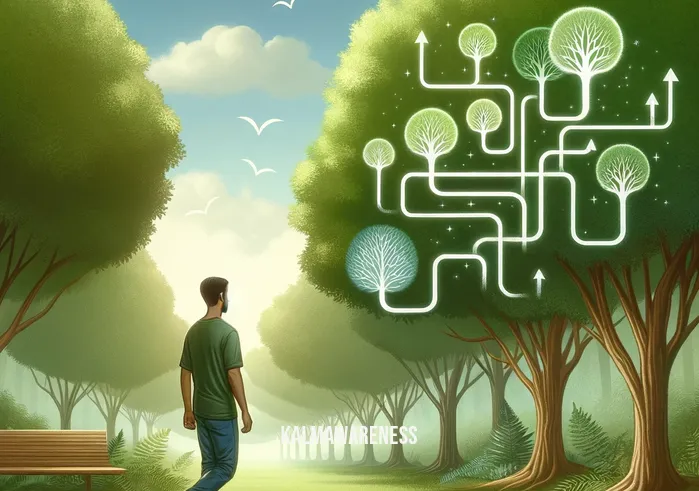The Intricacies of the Thought Cycle: Decoding Patterns and Paths to Well-being
In the vast landscape of human cognition, a phenomenon often surfaces and affects our daily lives – the thought cycle. Just like the rhythmic patterns of the ocean waves or the recurrent themes in a musical composition, our thoughts often loop, leading to patterns that can be constructive or detrimental to our well-being. In our quest to unravel the mysteries of the mind, we embark on a journey through rumination, patterns, awareness, shifts, and the breaks necessary for holistic health and well-being.
Understanding Rumination and its Impact
Our thoughts aren’t always linear. At times, they meander, twist, and turn, leading us to a mindful place, while at others, they trap us into anguish. When thoughts become a constant loop without resolution, it’s termed as ‘rumination’. Such recursive thinking, often focused on past events or future anxieties, can divert our attention from the present moment. As highlighted in a comprehensive article about self-reactivity, unchecked rumination can lead to increased stress, anxiety, and even depression.
Recognizing Patterns and Their Origins
Human minds are prone to establishing patterns. Be it in behavior, thoughts, or reactions, patterns provide a sense of familiarity. However, not all patterns serve our well-being. Delving deeper into the nature of these patterns, it’s been brought to my attention that patterns, both positive and negative, often arise from our past experiences, cultural background, or inherited beliefs. To navigate them, understanding their origins becomes paramount.
Cultivating Awareness in Thought
Awareness, as beautifully elucidated in the way of mindfulness, is the beacon that illuminates the dark corners of our mind. It’s about being present, acknowledging our thoughts without judgment, and understanding their impact on our emotions and behaviors. Developing such awareness can be cultivated through practices like meditation. Whether it’s a brief meditation on breath or more nuanced practices like aphantasia meditation, the goal is to attune oneself to the present moment. The mindful body serves as a testament to the power of awareness, allowing us to sync our mental and physical states.
Initiating the Shift Towards Positive Patterns
Awareness is only the first step. Taking cognizance of detrimental thought patterns warrants a shift. Shifting doesn’t imply suppression but a conscious redirection of thoughts. Tools like the gratitude method can be instrumental in fostering positivity. Often, it’s about touching that part of the body or the soul that feels neglected, offering it compassion and understanding.
The Importance of Taking Breaks
Breaks, both mental and physical, are integral for rejuvenation. While the mind grapples with thoughts, giving it a pause can work wonders. Techniques like earth day meditation or even culinary mindfulness practices like Becky’s mindful kitchen underscore the essence of taking a moment to breathe, relax, and be aware. This aligns with the philosophy of relax and be aware, offering our minds the solace they often seek.
In this segment, we’ve touched upon the profound dynamics of the thought cycle, the patterns it can lead to, the importance of mindfulness, and the avenues to shift and rejuvenate. But, as with any intricate subject, there’s more depth to explore. From understanding the nuances of self-reflection to the very methods that can help us control and channel our thoughts, our journey has only just begun.
Are you ready to delve deeper? Continue reading as we uncover more layers and insights on this transformative journey in the next segment.

Thought Cycle Dynamics: Harnessing Patterns for Personal Growth
As we navigate the vast universe of cognition and understanding, it becomes evident that our thought patterns, or the thought cycle, play an instrumental role in defining our experiences. Recognizing and directing this cycle can be the key to unlocking profound insights into our psyche and shaping our life’s trajectory. Let’s embark on a deeper exploration of this compelling concept.
Beyond the Basics: The Nuances of Thought Cycles
A deeper dive into our cognitive processes reveals that the way we think isn’t merely repetitive but also adaptive and evolutionary. The importance of the thought cycle lies in its ability to mold our responses, behavior, and even our worldview.
- Adaptive Nature: Just like muscles adapt to exercise, our thought processes refine and evolve with experiences. The journey from a novice to a self-reflective individual demonstrates this adaptive nature.
- Influence on Behavior: As iterated in a discussion about why certain individuals face recurrent patterns in relationships, the underlying thought cycle plays a pivotal role.
- Gateway to Self-awareness: Understanding one’s own actions and reactions can be directly traced back to one’s dominant thought patterns.
The Interplay between Thought Cycle and External Stimuli
Interestingly, our external environment, ranging from physical activities to external substances, influences the thought cycle. For instance, pondering on whether one can meditate while high or the sensation of sweating during meditation sheds light on this intricate interplay.
A Snapshot: Thought Cycle in Action
| Aspect of Thought | Implication | Practice to Enhance |
|---|---|---|
| Recurrence | Often leads to rumination or overthinking | Engaging in mindful activities |
| Adaptability | Ability to evolve with experiences | Mindful awareness of body |
| Influence on Emotions | Shapes feelings and responses | Harnessing the three components of mindfulness |
| Response to Stimuli | Reaction to external factors | Controlled environments, like Becky’s mindful kitchen |
| Link to Behavior | Direct impact on actions | Continuous self-assessment and feedback loops |
From the above table, we gather a systematic understanding of how the thought cycle operates, its implications, and ways to harness it positively.
Future Implications and Our Role
It’s essential to realize that while we can’t control every thought that enters our mind, we can control our reactions. By understanding the complexities and nuances of our thought cycles, we’re better equipped to mold them in ways that serve our well-being and personal growth.
As we conclude this chapter, it’s evident that the thought cycle isn’t just a repetitive loop; it’s a dynamic entity with the power to shape our lives. As we tread this path of discovery and introspection, the next segment promises to delve even deeper, presenting actionable insights and strategies. Stay with us as we explore transformative techniques and share real-life testimonials in the next chapter. Your journey towards mastering your thought cycle continues.

The Luminous Path: Hope and Inspiration Within the Thought Cycle
The landscape of our mind is constantly evolving, and our thought cycle plays a central role in this transformation. More than just a mechanism of cognition, the thought cycle also has the power to inspire, uplift, and provide hope. Within its intricate loops and patterns, there are countless stories of individuals who’ve harnessed its potential to bring about positive change in their lives.
Stories of Resilience and Transformation
One such individual, Jake, after attending a session on mindful awareness, made an incredible transition. Plagued by recurrent thoughts of self-doubt, he tapped into his thought cycle to pivot these into positive affirmations. Today, he’s a beacon of hope for many, running workshops that emphasize the importance of being aware of one’s thought patterns.
“The mind is everything. What you think, you become.“
— Buddha
Similarly, Ava, grappling with feelings of despair, stumbled upon the concept of shifting one’s mindset through gratitude. By repeatedly practicing gratitude, she initiated a change in her dominant thought patterns. Today, she’s a testament to the fact that our thought processes have the ability to shape our destiny.
“Change your thoughts and you change your world.“
— Norman Vincent Peale
Quotes to Illuminate the Thought Cycle’s Potential
In addition to real-life stories, certain words of wisdom shed light on the potential of our thought cycle:
“The happiness of your life depends upon the quality of your thoughts.“
— Marcus Aurelius“You become what you believe.“
— Oprah Winfrey“Earth Day meditation reminds us that our thoughts are like the earth – they have the ability to either nourish us or deplete us.”
A Journey Beyond the Mind’s Eye
For those with aphantasia, visualizing during meditation is a challenge. However, Sarah’s journey with aphantasia and meditation became a source of inspiration for many. Instead of being held back by her inability to create mental images, she focused on harnessing her other senses. Her experience underscores the fact that our thought patterns, even in the absence of visual imagery, possess immense power.
“It’s not what you look at that matters, it’s what you see.“
— Henry David Thoreau
The Unveiling Horizon: What’s Next?
As we’ve journeyed through the illuminating tales and profound words of wisdom, it’s clear that our thought cycle has boundless potential. It can be the harbinger of despair or the catalyst for hope, depending on how we harness it. As we gear up to delve further, the next chapter beckons with promises of tools, techniques, and practices that can help you master your thought cycle. Dive deeper with us, as we offer not just insights, but the tools to carve a brighter tomorrow.
@
Unraveling the Enigma: Delving into the Thought Cycle
The thought cycle is more than a mere cognitive process; it’s an intricate system that molds our perception, influences our decisions, and impacts our overall well-being. To truly grasp its depth and dynamics, it’s crucial to dissect it, layer by layer. This chapter is dedicated to unraveling the complexities of the thought cycle, presenting them in a digestible manner.
Key Elements of the Thought Cycle
Patterns: Like a recurring theme in a song, our thoughts often follow certain patterns. Recognizing these can provide insight into our underlying beliefs and emotions.
- Why some individuals feel unlucky in relationships can sometimes be traced back to thought patterns rooted in past experiences.
Rumination: Often, our minds get stuck in a loop, replaying certain events or feelings. This can be detrimental if these thoughts are negative.
- For example, understanding why one might feel overly sweaty during meditation can be connected to ruminative thoughts of anxiety or apprehension.
Awareness: It’s essential to be conscious of our thoughts. Only when we are truly aware can we begin to influence our thought cycle positively.
Shift: Changing our thought patterns isn’t easy, but it’s possible. This involves conscious effort, tools, techniques, and sometimes, external help.
- For instance, embracing the way of mindfulness can be a powerful tool in shifting from negative to positive thought cycles.
Break: Sometimes, the most effective way to influence our thought cycle is to take a break, step back, and reassess.
- Techniques such as focusing on a particular body part during meditation can provide the necessary break our mind needs from overwhelming thoughts.
Factors Influencing the Thought Cycle
Understanding the elements of the thought cycle is just the beginning. We must also recognize external and internal factors that can sway this cycle. Here’s a concise breakdown:
External Stimuli:
- Media consumption, interactions with others, and environmental changes can influence our thoughts.
- Delving into what the three components of mindfulness are can help mitigate the impact of overwhelming external stimuli.
Internal States:
- Our physical health, hormonal balances, and even diet can play a role. Did you know that mindful eating experiences like Becky’s mindful kitchen can have a profound effect on our thought processes?
Past Experiences:
- Memories, traumas, and past events shape our current thought patterns. Revisiting them with a fresh perspective can be therapeutic.
Belief Systems:
- The values and beliefs we hold can significantly steer our thought cycle.
Journeying Forward: The Final Exploration
Now, equipped with a clearer understanding of the thought cycle’s intricacies, we’re poised to journey into the final chapter. Here, we’ll converge our insights, bringing together strategies, actionable steps, and reflective practices to master our thought cycle. Join us in this culmination, where understanding meets transformation.
@
Reflecting on the Thought Cycle: A Journey’s End and New Beginnings
The thought cycle, like the intricate patterns in nature, is complex, beautiful, and essential to our well-being. As we reach the end of our exploration, it’s a moment to pause, reflect, and appreciate the myriad layers we’ve uncovered. But as with all good stories, this isn’t a definitive end. It’s an invitation to revisit, understand deeper, and apply our insights in ever-evolving ways.
Key Takeaways
Understanding Patterns and Their Influence: The cyclical nature of our thoughts, whether derived from mindful practices or past experiences, offers us a window into our innermost feelings and beliefs.
The Power of Awareness: Being truly present in our thoughts allows us to discern, evaluate, and make choices that nurture our mental health.
The Role of External and Internal Factors: From how we react to situations to the unique methods we can use, like aphantasia meditation, these factors contribute richly to our thought processes.
The Potential for Shift and Break: With knowledge comes power. Understanding the thought cycle gives us the tools to instigate positive change, be it through simple gratitude methods or more profound introspection.
Towards a Thoughtful Future
Our journey through the thought cycle has been enlightening. Yet, it’s only the tip of the iceberg. The world of mindfulness, cognition, and self-awareness is vast. With tools like Earth Day meditation, one can seamlessly integrate mindfulness into everyday life.
We encourage you, dear readers, to continue exploring this vast realm. If certain sections intrigued you, consider revisiting them, or dive into our comprehensive guide on mindful breathing. Every revisit offers fresh perspectives and deeper understandings.
A Heartfelt Thank You
We’re deeply grateful to you for embarking on this journey with us. Your curiosity, engagement, and thirst for understanding inspire us to bring more insightful content your way. Here’s a promise: In our next edition and those that follow, we’ll delve into even more fascinating terrains of the human mind and spirit. Until then, stay curious, stay aware, and always remember the beauty of the thought cycle.
To more discoveries and deeper reflections,
The KalmAwareness Team.



